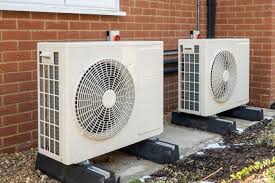Exploring the Advantages of Air Source Heat Pumps

Air source heat pumps (ASHPs) have emerged as a highly efficient and environmentally friendly heating and cooling solution for homes, businesses, and communities. By harnessing the ambient heat from the air, ASHPs offer a range of benefits that extend far beyond traditional heating and cooling systems. Let's delve into the advantages of embracing air source heat pumps.
1. Energy Efficiency
One of the most significant advantages of air source heat pumps is their exceptional energy efficiency. Unlike conventional heating systems that rely on burning fossil fuels, ASHPs transfer heat from the outdoor air into indoor spaces using a refrigerant cycle. This process requires significantly less energy than generating heat through combustion, resulting in lower energy consumption and reduced utility bills. In fact, ASHPs can achieve efficiency levels of over 300%, meaning they can produce more heat energy than the electrical energy they consume.
2. Cost Savings
The energy efficiency of air source heat pumps translates into tangible cost savings for homeowners and businesses. By reducing energy consumption for heating and cooling, ASHPs can lower monthly utility bills and provide long-term savings on energy costs. Additionally, ASHPs eliminate the need for separate heating and cooling systems, reducing equipment and maintenance expenses over time. With incentives such as rebates, tax credits, and financing options available in many regions, the upfront cost of installing an ASHP can also be offset, making it a cost-effective investment in the long run.
3. Environmental Sustainability
ASHPs are environmentally friendly heating and cooling solutions that produce fewer greenhouse gas emissions compared to traditional heating systems. By utilizing renewable heat energy from the air, ASHPs help reduce reliance on fossil fuels and mitigate climate change. Additionally, ASHPs operate without combustion, eliminating emissions of harmful pollutants such as carbon monoxide, nitrogen oxides, and particulate matter. As a result, ASHPs contribute to cleaner air and a healthier environment for both present and future generations.
4. Versatility
Air source heat pumps offer versatility in meeting heating and cooling needs throughout the year. In heating mode, ASHPs extract heat from the outdoor air and transfer it indoors to warm living spaces. In cooling mode, the refrigerant cycle is reversed, allowing ASHPs to absorb heat from indoor spaces and release it outdoors, effectively cooling the indoor environment. Some ASHPs even feature built-in systems for domestic hot water heating, providing a comprehensive solution for year-round comfort.
5. Quiet Operation
ASHPs are known for their quiet operation, making them suitable for residential and commercial applications where noise levels are a concern. Unlike traditional HVAC systems that rely on noisy compressors and fans, modern ASHPs are designed with sound-dampening features and advanced technologies to minimize noise during operation. As a result, ASHPs provide comfortable indoor environments without disrupting daily activities or disturbing occupants.
6. Reliability and Durability
Air source heat pumps are engineered for reliability and durability, offering years of trouble-free operation with minimal maintenance requirements. With fewer moving parts compared to combustion-based heating systems, ASHPs are less prone to mechanical wear and tear, reducing the likelihood of breakdowns and costly repairs. Additionally, many ASHP manufacturers offer warranties and service agreements to provide peace of mind and ensure the long-term performance of their products.
7. Independence from Fossil Fuels
By utilizing renewable heat energy from the air, ASHPs offer independence from fossil fuels and the volatile energy market. This independence provides homeowners and businesses with greater control over their energy supply and reduces vulnerability to fluctuations in fuel prices and availability. Additionally, ASHPs can be powered by electricity generated from renewable sources such as solar or wind, further enhancing their sustainability and reducing reliance on non-renewable energy sources.
8. Space Savings
ASHPs require less space for installation compared to traditional heating and cooling systems, making them ideal for homes and buildings with limited space availability. Outdoor units can be mounted on walls or placed on the ground, while indoor units are compact and can be installed in various locations, including walls, ceilings, or floors. The compact size of ASHPs makes them suitable for retrofitting existing buildings or integrating into new construction projects without sacrificing valuable indoor or outdoor space.
9. Improved Indoor Air Quality
Air source heat pumps contribute to improved indoor air quality by circulating and filtering air throughout the indoor environment. Advanced filtration systems capture dust, allergens, and other airborne particles, reducing indoor air pollutants and allergens that can cause respiratory problems and allergies. Additionally, ASHPs maintain optimal humidity levels, preventing the growth of mold and mildew and creating a comfortable and healthy indoor environment for occupants.
10. Government Incentives and Rebates
Many governments and utilities offer incentives, rebates, and financial assistance programs to encourage the adoption of air source heat pumps and other energy-efficient technologies. These incentives can help offset the upfront cost of purchasing and installing ASHPs, making them more accessible and affordable for homeowners and businesses. By taking advantage of available incentives, individuals and organizations can maximize their savings and accelerate the transition to cleaner, more efficient heating and cooling solutions.In conclusion, air source heat pumps offer a range of benefits that make them an attractive option for heating and cooling residential, commercial, and institutional buildings. From energy efficiency and cost savings to environmental sustainability and improved indoor comfort, ASHPs provide a comprehensive solution for meeting heating and cooling needs while reducing reliance on fossil fuels and mitigating climate change. As awareness of the advantages of air source heat pumps grows and technology continues to advance, their widespread adoption is poised to play a significant role in shaping a cleaner, more sustainable future for all.
